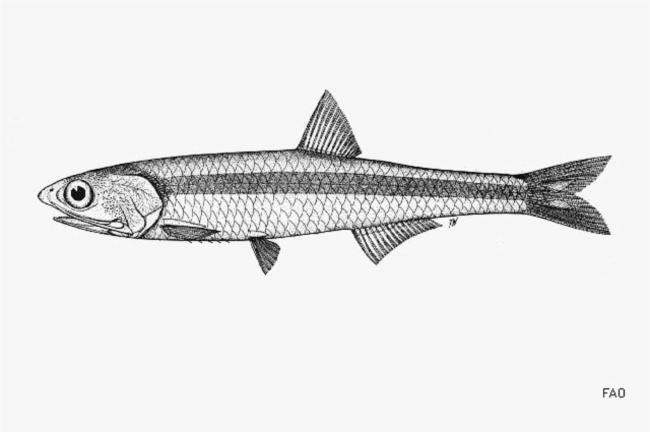Shorthead Anchovy, Encrasicholina heteroloba (Rüppell 1837)
Other Names: De Vis's Anchovy, Devis' Anchovy, East Indian Anchovy

Illustration of a Shorthead Anchovy, Encrasicholina heteroloba. Source: FAO / FishBase. License: CC by Attribution-NonCommercial
Summary:
A milky white anchovy with a broad silvery stripe from behind the upper part of the gill cover to the caudal-fin base (width of stripe almost equal to pupil diameter), a narrow black stripe along the the upper margin of the silver band, top of the head black, and a silver cheek and gill cover.
Cite this page as:
Bray, D.J. 2024, Encrasicholina heteroloba in Fishes of Australia, accessed 01 Jul 2025, https://fishesofaustralia.net.au/home/species/4313
Shorthead Anchovy, Encrasicholina heteroloba (Rüppell 1837)
More Info
|
Distribution |
From about Broome, Western Australia, to Cooktown, Queensland. Elsewhere, the species is widespread in the Red Sea and Indo-west Pacific - known from the northern Indian Ocean (from Gulf of Aden to Andaman Islands), and the western Pacific Ocean (southern Japan to Southeast Asia, northern Australia, Fiji, and Tonga). |
|
Features |
Dorsal and anal fins with three unbranched rays; pseudobranchial filaments 18–22 (rarely 17, modally 19); gill rakers 14–23 (modally 20) in upper series on first gill arch, 20–26 (23) in lower series, 36–49 (42) in total; gill rakers 11–17 (14) in upper series on second gill arch, 19–25 (21) in lower series, 30–40 (34) in total; gill rakers 10–14 (12) in upper series on third gill arch, 10–14 (13) in lower series, 21–28 (23, 25) in total; gill rakers 6–12 (10) in upper series on fourth gill arch, 8–11 (10) in lower, 15–23 (21) in total; prepelvic scutes 3–7 (5); head rather long, length 24.9–28.9 % (mean 26.8 %) SL; upper jaw long, its posterior tip extending beyond posterior margin of preopercle; first unbranched dorsal and anal fin rays minute, length 0.4–1.8 % (mean 1.0 %) and 0.3–1.8 % (mean 0.9 %) SL, respectively; D– P1 (distance from origin of dorsal fin to pectoral-fin insertion) rather long, 97.5–126.5 % HL (mean 110.4 %). |
|
Remarks |
Encrasicholina heteroloba (described from the Red Sea) is a senior synonym of E. devisi (described from Cape York, Queensland, Australia) |
|
Similar Species |
Encrasicholina heteroloba differs from other species in the genus in having a long upper jaw (posterior tip extending beyond the posterior margin of the preopercle), three unbranched rays in the dorsal and anal fins, and a shorter relative head length (24.9–28.9 % of standard length). Encrasicholina pseudoheteroloba differs from its congeners in having a long upper jaw (posterior tip extending beyond the posterior margin of the preopercle) and two unbranched rays in the dorsal and anal fins. |
|
Etymology |
The specific name is from the Greek heteros (different, other) and the Latin lobus (= a lobe), possibly in reference to the “membranous lobes” (= scales) on the caudal fin. |
|
Species Citation |
Engraulis heteroloba Rüppell 1837, Fische des Rothen Meeres 3: 79, pl. 21(4). Type locality: Massawah, Red Sea. |
|
Author |
Bray, D.J. 2024 |
|
Resources |
Shorthead Anchovy, Encrasicholina heteroloba (Rüppell 1837)
References
Grant, E.M. 1975. Guide to Fishes. Brisbane : Queensland Government, Co-ordinator General’s Department 640 pp. (p. 88, as Encrasicholina devisi).
Hata, H. & Motomura, H. 2017. Validity of Encrasicholina pseudoheteroloba (Hardenberg 1933) and redescription of Encrasicholina heteroloba (Rüppell 1837), a senior synonym of Encrasicholina devisi (Whitley 1940) (Clupeiformes: Engraulidae). Ichthyological Research 64: 18–28 https://doi.org/10.1007/s10228-016-0529-4
Hata, H., Motomura, H. & Ishimori, H. 2012. First Japanese record of an engraulid fish, Encrasicholina devisi (Clupeiformes), collected from Kagoshima Prefecture, southern Japan and comparisons with congeners. Japanese Journal of Ichthyology 59: 125–134 https://doi.org/10.11369/jji.59.125
Rüppell, W.P.E. 1837. Neue Wirbelthiere zu der Fauna von Abyssinien gehörig. Fische des Rothen Meeres. Frankfurt Vol. 3, pp. 53–80, pls 15–21. See ref at BHL
Whitehead, P.J.P. 1965. A review of the elopoid and clupeoid fishes of the Red Sea and adjacent regions. Bulletin of the British Museum (Natural History) Historical Series 12(7): 225-281 figs 1-4
Whitehead, P.J.P., Nelson, G.J. & Wongratana, T. 1988. FAO Species Catalogue. Clupeoid fishes of the world (Suborder Clupeoidei). An annotated and illustrated catalogue of the herrings, sardines, pilchards, sprats, anchovies and wolf-herrings. Engraulididae. FAO Fisheries Synopsis. No. 125 Vol. 7 Pt 2. 305-579 pp.
Whitley, G.P. 1940. Illustrations of some Australian fishes. The Australian Zoologist 9(4): 397-428 figs 1-45 pls 30-31 (p. 404, fig. 11, as Amentum devisi)
Wongratana, T. 1987. Two new species of anchovies of the genus Stolephorus (Engraulidae), with a key to species of Engraulis, Encrasicholina, and Stolephorus. American Museum Novitiates 2876: 1–8.
Wongratana, T., Munroe, T.A. & Nizinski, M.S. 1999. Family Engraulidae. pp. 1698-1753 in Carpenter, K.E. & Niem, V.H. (eds) The Living Marine Resources of the Western Central Pacific. FAO Species Identification Guide for Fisheries Purposes. Rome : FAO Vol. 3 pp. 1397-2068.

